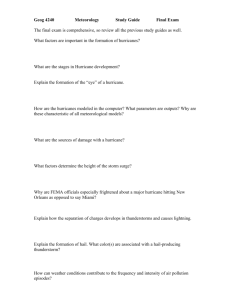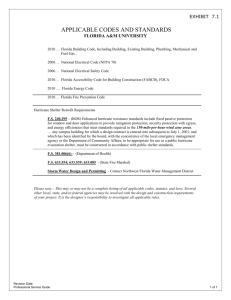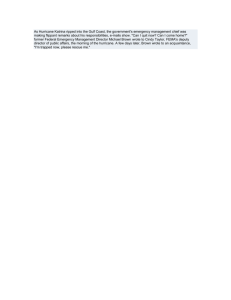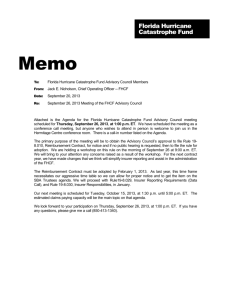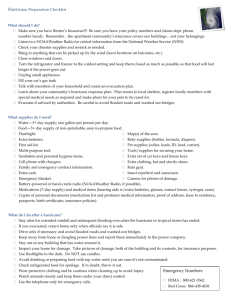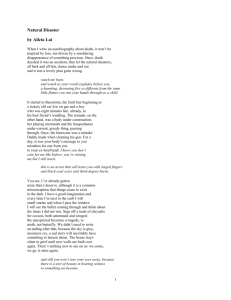PIRC Working Groups
advertisement
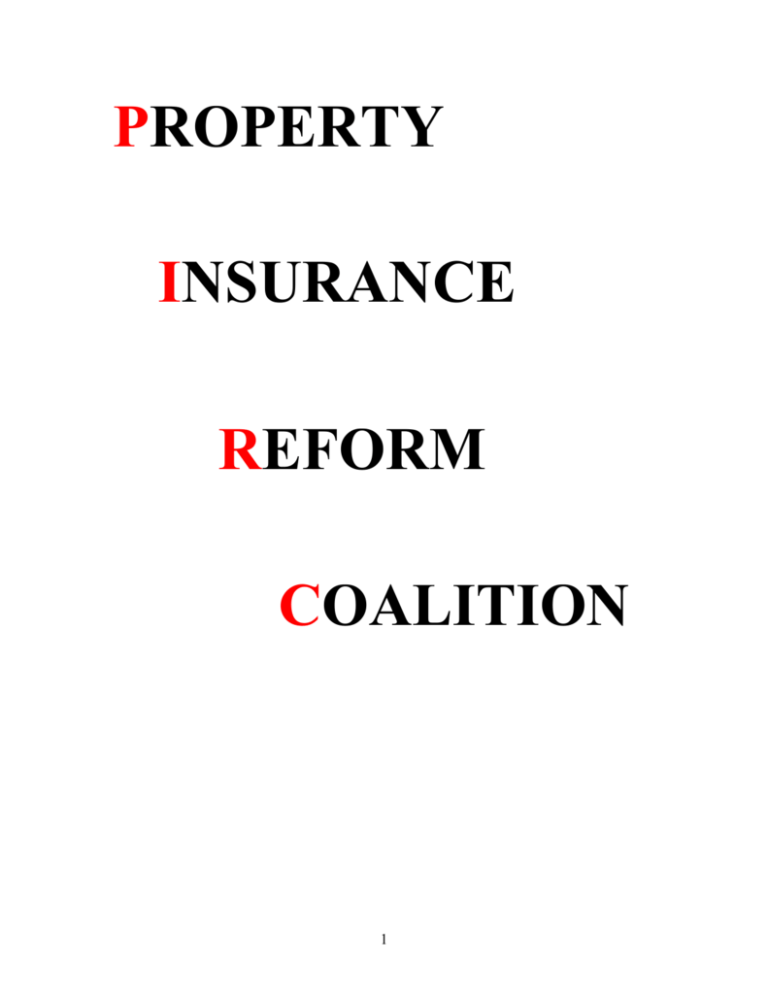
PROPERTY INSURANCE REFORM COALITION 1 PIRC Work Units Charges, Assumptions and Specific proposals for discussion Work Unit I—“Wind” Insuring, Funding and spreading the exposure Work Unit II—“Citizens” Redesign of the residual market including Citizens structure and operations Work Unit III—“Mitigation” Building Codes, Construction and related incentives Work Unit IV—“Regulatory Reform” Eliminating bureaucratic and regulatory barriers to new insurance capital 2 WORK UNIT I –“WIND” Insuring, funding and spreading the exposure This unit will develop solutions regarding the “uninsurable” portion of Florida’s catastrophic wind exposure by operating under the assumption that a significant portion of Florida’s hurricane risk has become uninsurable by the private market. Any solution should reflect a pre-event funding approach that recognizes all Floridians and visitors benefit from affordable and available property insurance coverage. In developing it’s recommendation the group will review existing proposals, including the so-called Democrat proposal, other proposals that have been offered, and those currently on the Governor’s task force agenda or any combination of the above. Its deliberations shall also be guided by the following assumptions: 1. 2. 3. Any state wind or Cat fund money can be a cost-effective means of reducing future hurricane losses, but this money should never be diverted to non-mitigation purposes. Revisions of any wind or Cat fund assessment process should avoid any action that would have an adverse impact on the bond markets or would reduce the surplus available to insurers by affecting the accounting treatment of future assessments. As part of the pre-event approach, any Cat or wind fund should include an appropriate risk load and early cash build up factor. UNIT I PARTICIPANTS _____________________________ Unit Manager _____________________________ Staff Assistant MEMBERS _____________________________ _____________________________ _____________________________ _____________________________ _____________________________ _____________________________ Special Counsel: Bryon Ehrhart, Aon Re 3 Specific Proposals for Discussion I. Florida Hurricane Catastrophe Fund (and other State Reinsurance Coverage Options) Issue #1: Lower Cat Fund Retention (i.e., amount of residential hurricane losses that insurer must pay before being reimbursed) Current Law: $5.3 billion retention for all insurers combined for 2006, increased annually by the same percentage as the growth in the Fund’s exposure. (Legislation in 2005 reset retention to $4.5 billion, which grew to $5.3 billion in 2006). A separate retention is calculated for each insurer, based on its percentage of total Cat Fund premiums; e.g., an insurer paying 10% of the total Cat Fund premiums has a retention of $530 million (10% of $5.3 bil.). The full retention applies to each hurricane, but drops to one-third of full retention for the third and each additional hurricane (in order of loss magnitude) in a single year. Cat Fund premiums must be set at the “actuarially indicated” amount (generally, the average annual expected loss) based on hurricane loss projection models approved by the Florida Commission on Hurricane Loss Projection Methodology, plus a 25% “rapid cash build-up factor”(per SB 1980). The 2006 premium equals 6.7% of the coverage amount (i.e., a 6.7% “rate on line”). Options: (1) Lower the 2007 retention for all insurers, (e.g., to $3 bil., $4. bil., $4.5 bil., or reset to the 2006 level of $5.3 bil.), subject to annual growth thereafter pursuant to current law. (2) Lower the retention, but charge a higher premium (e.g., 50%, 75%, or 100% risk load, rather than 25%). (3) Provide an annual retention (such as $5 bil. - $7 bil.) rather than a per hurricane retention, but have a small, per hurricane retention (such as $500 mil.$1 bil.) that must still be met after the annual retention is met. Issue #2: Temporary Offer of Cat Fund Coverage Below Retention Current Law: SB 1980 allowed limited apportionment companies ($25 mil. in surplus or less and writing at least 25% of its property premiums in Florida) to purchase up to $10 million in coverage above a retention equal to 30 percent of the insurer’s surplus (well below the current retention), at a premium of 50% of 4 the coverage amount selected (i.e., 50% “rate on line”). Coverage is reinstated at no additional premium for a second hurricane, but not for additional hurricanes. Available only for the 2006 contract year. Options: 1. Reenact current law provision for 2007. Consider raising retention above 30% of the insurer’s surplus. 2. For 2007, offer all insurers (not just limited apportionment companies) the option of purchasing coverage below the retention, at rates comparable to (or less than) market level prices. For example, assuming the retention in 2007 remains at $5.3 billion, offer each insurer its share of $4.3 billion excess of $1 billion at a 60% rate on line, $3.3 billion excess of $2 billion at a 50% rate on line, and $2.3 billion excess of $3 billion at a 45% rate on line. Reimbursement would be provided for 90% of losses. Coverage would be automatically reinstated at no additional charge for a second hurricane. Issue #3: Increase Maximum Limit of Cat Fund Coverage Current Law: Annual reimbursement to all insurers is limited to $15 billion annually, increased annually by the same percentage as the growth in the Fund’s exposure, but not to exceed the dollar growth in the cash balance of the Fund. Due to Cat Fund losses in 2004 and 2005, the $15 billion limit has not increased since it was legislatively increased to $15 billion in 2004. A separate annual reimbursement limit is calculated for each insurer, based on its share of total Cat Fund premiums. For example, an insurer that pays 10% of total Cat Fund premiums is limited to a maximum annual reimbursement of $1.5 bil. (10% of $15 bil.). Option: 1. Increase the $15 billion limit for 2007 (e.g., $17 bil. - $20 bil.) 2. Require the $15 billion limit to grow annually by the same percentage as the Fund’s exposure, regardless of the change in the Fund’s cash balance. Issue #4: Offer Additional Cat Fund Coverage as Incentive to Take Policies out of Citizens Current Law: Not addressed in current law. (SB 1980 significantly restricted the payment of cash take-out bonuses to insurers by Citizens.) Option: 1. Offer additional Cat Fund coverage to an insurer that takes a specified minimum number of policies out of Citizens. For example, if an insurer takes out 5 at least 10,000 policies, offer coverage below the $5.3 billion retention, such as $2.3 billion in excess of $3 billion, at a rate of 30% rate on line. This coverage layer would apply to all of the insurer’s residential policies, but the percentage reimbursement would be limited to the percentage of the insurer’s total Cat Fund premium that is paid for the take-out policies. This same percentage would be applied to reduce the 30% rate on line. Example: An insurer takes 10,000 policies out of Citizens, which account for 20% of the insurer’s Cat Fund premium. The insurer would be allowed to purchase coverage below the retention, for its share of $2.3 billion in excess of a $3 billion. For this layer, the Cat Fund would reimburse the insurer for 20% of its losses, for which the insurer would pay a 6% rate on line (20% of a 30% rate on line). (Reimbursement would be limited to 90% of losses for an insurer whose take-out policies account for more than 90% of its Cat Fund premium.) Limit the benefit to a specified period, e.g., three years, contingent on renewing the take-out policies. The rate on line could be increased over this three-year period. Proportionately reduce the reimbursement if an insurer non-renews other policies while assuming Citizens policies (i.e., measure net increase in insurer’s Cat Fund exposure). Issue #5: Changing the Renewal Date of the Cat Fund to Conform with the Global Reinsurance Market Current Law: Currently, the contract year for Cat Fund coverage begins on June 1. However, according to OIR, most property casualty reinsurance contracts are negotiated and renewed in January of each year. Asian and some European catastrophic risk reinsurance is renewed in March/April, while most Florida property reinsurance is negotiated and renewed for a June renewal date to coincide with the FHCF. That is, many Florida insurers are going to the market after the rest of the global reinsurance market has largely cleared. In tight markets, such as those Florida companies are currently facing, this puts additional stress on both availability and affordability. According to OIR, if the renewal date for Cat Fund coverage were changed to have Florida companies in the market in March or April, or possibly even January, the market opportunities and competitive pressures would work more to the benefit of Florida companies and consumers. Option: Change the renewal date for Cat Fund coverage from June 1 to an earlier date, such as January, March, or April. 6 Issue #6: Funding Losses in the Cat Fund Current Law: If the cash balance of the Cat Fund is insufficient to meet its obligations, the SBA is authorized to issue revenue bonds funded by emergency assessments levied as surcharges against all property and casualty insurance premiums, including surplus lines insurance, except for workers’ compensation and, until June 1, 2007, medical malpractice insurance. Annual assessments are capped at 6 percent of premium for losses from any one year and 10 percent of premium for losses from multiple years. The recent $1.35 bil. bond issue to fund losses for 2004 and 2005 is expected to result in a 1 percent assessment for six years. Options: 1. Expand the assessment based of the Cat Fund to include workers’ compensation. According to OIR, this would add approximately $4 billion to the assessment base, which currently totals about $35 billion. 2. Impose an additional 1 cent sales tax for deposit into the Cat Fund. This would generate approximately $3.5 billion. Issue #7: Restructure the current CAT Fund to be modeled after the National Flood Insurance Program Option: Revise the Cat Fund to provide coverage for the first $100,000 of loss per policy. Private insurers remain responsible for 10 percent of losses covered by the Fund and for losses above $100,000 per policy. Issue #8: Provide Cat Fund Coverage for Commercial Property Current Law: The Cat Fund covers only residential property (including condominium associations and apartment buildings). The Cat Fund does not otherwise cover commercial property. (The 1993 act creating the Cat Fund included coverage for commercial property, but the 1995 act deleted this coverage before the Fund began providing coverage.) Option: Require the Cat Fund to cover commercial property. Issues to consider: o whether coverage would be mandatory or optional for insurers; o whether certain large or unique risks should be excluded; o whether coverage and pricing should be addressed differently than for residential coverage, due to unique nature of risks; such as providing quota share coverage (e.g., covering 50% of the loss, at a rate of 50% of the insurer’s premium.) 7 o whether current assessment limits are adequate. Issue #9: Appropriations from the Cat Fund Current Law: The Florida law (statute) requires that the assets of the Cat Fund be used exclusively for paying hurricane loss obligations, debt service on revenue bonds and financing arrangements, reinsurance costs, administrative expenses, and an annual appropriation for hurricane loss mitigation programs. The law requires an annual appropriation for hurricane loss mitigation programs of at least $10 million, but not to exceed 35 percent of the prior year’s investment income. Legislation in 1999 required that the $10 million must be appropriated to the Department of Community Affairs, of which $7 million must be used for programs to improve the wind resistance of residences and mobile homes and $3 million must be used to retrofit existing facilities used as public hurricane shelters. The law further directs that 40 percent of the $7 million ($2.8 million) be used to inspect and improve tie-downs for mobile homes and that 10 percent ($700,000) be allocated to the State University System dedicated to hurricane research. Beginning in 1997, the Legislature appropriated $10 million each year from the Cat Fund, but appropriated $30 million in 2002 and $20 million in 2003, largely for beach renourishment purposes. Following the 2004 hurricanes, the Legislature appropriated $150 million from the Cat Fund to reimburse policyholders for the expense of paying multiple deductibles from two or more hurricanes. Option: 1. Amend the State Constitution to limit the use of the assets of the Cat Fund (i.e., restrict legislative appropriations) to the purposes currently required by statute (as summarized in first paragraph under Current Law). Also require that any appropriation from the Cat Fund in excess of $10 million be in a separate bill for that purpose only and be approved by a super-majority (e.g., three-fourths) of the membership of each house of the Legislature. 8 House Democrats’ Hurricane Insurance Fund Proposal There is a Hurricane Insurance Crisis in Florida After two devastating hurricane seasons, Florida’s hurricane insurance market is in the midst of a crisis. The billions of dollars in damage left behind by these destructive storms have forced homeowner’s insurance premiums to skyrocket out of control. Floridians are entering the 2006 Hurricane Season more vulnerable than ever. Insurance companies in South Florida have reported insolvency and others are moving towards liquidation. Other companies are simply choosing to stop writing policies in Florida. And insurance companies that have remained in the market continue to request rate increases ranging from 20 percent to as high as 60 percent. House Democrats Propose Creating the Hurricane Insurance Fund House Democrats propose reforming Florida’s Property Insurance Market by introducing the Florida Hurricane Insurance Fund to stabilize the market. The main components of the Democratic proposal include: The Hurricane Insurance Fund will cover losses resulting from a hurricane as declared by the National Weather Service (not damage from tropical or unnamed storms). This fund will share the risk with private insurance companies for wind-storm coverage. Insurance companies issuing homeowner’s insurance policies will be writing the hurricane policies on behalf of the Hurricane Insurance Fund while other wind related coverage will be written by the insurer in order to provide policyholders with a single contact (this will also reduce administrative costs). The Hurricane Insurance Fund will cover hurricane losses up to $100,000 per policy with varying mandatory hurricane deductibles. Surpluses will accumulate during good hurricane seasons so that funds are available during bad years. In the event of an emergency, the fund could bond, borrow from a federal disaster fund if one is created, or purchase reinsurance, if needed. With the fund assuming the risk for parts of hurricane damage, private insurance companies will compete to write traditional homeowner’s policies, and increased competition will be witnessed in Florida. Additionally, policyholders will only work with a single claims adjuster, reducing administrative overhead and expediting the insurance claims process. 9 Long-term premium savings would be witnessed as the insurance market will be stabilized and drastic insurance premium increases will diminish. Additionally, the fund would not need to make a profit, would not pay taxes, risk would be more predictable, and having more private companies vie for homeowner’s policies will increase competition in our state. Strong mitigation efforts are a major component of the proposed legislation. Longterm mitigation efforts should reduce hurricane damage thus producing stabilized rates. Mitigation programs will be offered through a series of no and low interest loan programs. Homeowners who engage in mitigation efforts will be able to witness reduced fund premiums as an incentive for having “hurricane proof homes.” Longterm, as the number of vulnerable homes decreases, the risk to the fund would be reduced allowing for cost savings to be realized. Hurricane Insurance Fund is Not a Subsidy It is important to realize that the Hurricane Insurance Fund will not subsidize hurricane insurance for Floridians. Rather, the fund will allow for risk-adjusted, actuarially sound premiums to be collected to provide the much needed hurricane coverage that our citizens deserve. With the market stabilized, the private sector will increase the supply of affordable homeowner’s insurance in Florida, offer stabilized premiums for Floridians and increase efficiency in Florida’s hurricane insurance market. Why the Democratic Plan to Stabilize the Insurance Market is Different Many competing ideas about how to reform hurricane insurance have come to surface during the past several months. However, the House Democratic plan is the only one that will stabilize the insurance market, increase market competition that will stabilize rates and improve customer service. Our plan is more than just a good first step- it is a responsible, innovative and commonsense proposal that will create a solution for Florida homeowners. 10 WORK UNIT II –“CITIZENS” Redesign of the residual market including Citizens structure and operations This unit will consider any needed reforms to assure that Citizens serves its purpose of providing essential property insurance coverage only to those who are unable to obtain coverage in the voluntary market; and only to the extent and time such coverage is needed. It will consider minimizing any unnecessary burden on voluntary market policyholders or the growth of the voluntary market. It will propose a redesign/renaming of Citizens so that it fits with any changes proposed by any of the other groups. Deliberations shall be guided by the following assumptions: 1. 2. 3. 4. A property owner should be ineligible for coverage from Citizens if there is any voluntary market insurer willing and able to cover the property. Citizens’ coverages should take into account the limited nature of Citizens’ resources and Citizens’ dependence on assessments. Residual market rates should be actuarially sound and designed to minimize the possibility of future assessments. In order to assure that rates are not an incentive for a property owner to seek coverage in the residual market, Citizens’ rates should never be competitive with voluntary market rates. Revisions of the Citizens’ assessment process should avoid any action that would have an adverse impact on the bond markets or would reduce the surplus available to insurers by affecting the accounting treatment of future assessments. UNIT II-- PARTICIPANTS _____________________________ Unit Manager _____________________________ Staff Assistant MEMBERS _____________________________ _____________________________ _____________________________ _____________________________ _____________________________ _____________________________ 11 Specific proposals for Discussion Underlying information If Florida’s commercially uninsurable wind exposure is handled efficiently by other work groups of PIRC, the need for a full functioning, all perils, state operated homeowners insurance company like Citizens (not to mention a separate wind pool) is diminished considerably. Therefore, should any zero based approach implementing a statewide wind solution also feature either the elimination of Citizens or its complete redesign to an entity that conforms to the new catastrophic wind provider? There is also legitimate concern that Citizens provides subsidized insurance coverage to some homeowners or businesses that can afford to mitigate but choose not to in part because coverage from Citizens allows them to avoid spending money on the upgrades. Is there a role for Citizens or its successor in this regard? Elimination of Citizens, while desirable, may not be as achievable even if “all” wind was underwritten by the state. There will always be those who believe the state should provide at least limited and temporary coverage for some risks; even those that are considered uninsurable by the admitted market for perils other than wind or because of policyholder negligence. However, shouldn’t any successor to Citizens eliminate all the elements known to have caused it to endure and grow beyond its intended and necessary scope? If yes, then how could this be achieved? One proposal is to convert Citizens to a provisional property facility that would emphasize assisting homeowners to find needed voluntary coverage and to mitigate, providing only temporary minimum coverage until such voluntary coverage or mitigation is secured. It could be structured and governed as follows: 1. Citizens’ board would continue as it does now but would manage a new limited insurance provider and a modified Florida Market Assistance Plan (FMAP) called the Florida Provisional Property Facility (FPPF). Its primary role would be to help consumers find voluntary coverage immediately, if available anywhere in the state or, if not available, to improve their home or business underwriting factors so they can qualify for voluntary coverage within three years. 12 2. The FPPF would still provide insurance protection but only the minimum coverage necessary to meet the requirements of the secondary mortgage market, roughly that of an HO-8 policy. Other limitations could be, sinkhole coverage limited to $10,000 with the option to buy additional coverage up to $50,000, no replacement cost on contents, no coverage for theft of property away from premises, disappearing deductibles, ACV on roof damage. 3. Coverage would only be provided until FPPF located an insurance company willing to insure the risk or until the policyholder voluntarily terminated coverage or until the third renewal, whichever comes first. 4. New risks would be inspected, photographed and provided a checklist of the necessary underwriting information needed to obtain voluntary coverage at the end of three years. FPPF would assist financially challenged policyholders in accessing state sponsored mitigation loans and provide other assistance necessary to improve their structure for the admitted market. This could include certification that the mitigation is complete signifying to the voluntary market that this property meets the grade. The FPPF board, for hardship or unusual cases, could grant oneyear coverage extensions after the third renewal. 5. The new state facility providing catastrophic wind coverage would deal with the FPPF the same as it does for every other company except there would be no need and thus no incentives (i.e. assessment credits) for FPPF to voluntarily write the entire wind. 6. Unlike Citizens, there would be only one account providing only two policies; one a multi-peril policy for homeowners, the other a wind-only policy for commercial properties. Any wind coverage provided by FPPF vs. that of the state catastrophic wind provider would not cover highly susceptible property like outdoor pool cages, fences or docks and would have limited options, including only one deductible (on personal and one commercial). Contents and roof damage would be insured at Actual Cash Value. 7. New policies would be removable whenever the FPPF, any agent, or insurer can find voluntary coverage equal to or better than that of the FPPF at an approved admitted market rate. The board would oversee and prior approve large removals to reduce disruption and fiscal impact on the facility. 8. Agents would be paid a graded commission that is higher for premiums below a certain threshold and lower for premiums above a certain threshold-- for new submissions, midterm change processing and claims assistance. They could however, bill or charge an upfront policy fee to the 13 policyholder for any direct costs incurred for inspections, photographs, reports, certificates, etc. 9. Any duly licensed agent can submit policies and assist a policyholder in finding coverage with the FPPF. There are no appointments, contracts or lengthy certifications required, just a one-time registration and processing fee. 10. Consumer Choice is no longer necessary, the agent commission is fully earned up front and any admitted carrier can remove any policy anytime. There are no bonuses paid and no formal requirements regarding takeouts other than an OIR approval to insure an orderly process if the number to be removed by one carrier is substantial. 11. Rates charged by the facility must be implemented on a “use and file” basis with no regurgitation requirement. However individual risks must be surcharged whenever the OIR notifies the new facility based on evidence of an admitted rate being higher than the facility’s rate. OIR is not required to proactively monitor and make surcharge recommendations but must advise the facility when the information is presented to it. 14 UNIT III—“MITIGATION” Building codes, construction and related incentives This unit will consider actions necessary to reduce hurricane losses through mitigation and improved construction methods and materials. It will consider better methods for extending and implementing the current state mitigation funding administered by the DFS and will make any recommendations that eliminate disincentives to hurricane resistant construction. Deliberations will be conducted under the following assumptions: 1. The state should create permanent incentives for homeowners to make their properties more hurricane-resistant and to buy and build hurricane-resistant properties. 2. Building codes and code enforcement in high-risk areas should be strong enough to assure that newly constructed properties are more hurricane-resistant going forward. UNIT III--PARTICIPANTS _____________________________ Unit Manager _____________________________ Staff Assistant MEMBERS _____________________________ _____________________________ _____________________________ _____________________________ _____________________________ _____________________________ 15 Specific Proposals for discussion II. Mitigation/Premium Discounts Issue #1: Funding Mitigation Measures Current Law: For 2006-2007, $250 million of non-recurring funds was appropriated from General Revenue for the Florida Comprehensive Hurricane Damage Mitigation Program within the Department of Financial Services (DFS). The unexpended balance reverts after three years (June 30, 2009). The program provides for free inspections of site-built, residential property, to determine what mitigation measures are needed to reduce vulnerability to hurricane damage and provides for 50 percent matching grants (up to $5,000) to encourage retrofitting of homes. Up to 100 percent grants (up to $5,000) are available to low-income homeowners. DFS must adopt rules establishing priorities for grants based on objective criteria that gives priority to reducing the states’ probable maximum loss for hurricanes. and may further establish priorities based on the insured value, whether the dwelling is insured by Citizens, and whether the area has sufficient resources to perform the retrofitting. Options: 1. Maintain or expand the State’s financial commitment to fund the program. 2. Expand the funding for free inspections to encourage more homeowners to mitigate regardless of whether matching grants are available. 3. For future appropriations for mitigation grants, lower the percent match (e.g., from 50% to 20% or 30%) to fund additional homes. 4. Exempt mitigation materials from the sales tax. 5. Review DFS allocation of mitigation funds and priorities for grants and recommend any changes determined appropriate. Issue #2: Savings for Homeowners through Mitigation Current Law: Insurers are required by law to provide premium credits or discounts for homeowner’s insurance for properties on which construction techniques have been installed which reduce the amount of loss in a windstorm. These construction techniques include roof strength, roof covering performance, roof-towall strength, wall-to-floor-to-foundation strength, opening protection, and window, door, and skylight strength, etc. Individual discounts or credits generally 16 range from 3% to 25% and a fully mitigated property can qualify for total credits ranging from 20% to 42% off its wind insurance premium. SB 1980 required OIR to reevaluate the insurance discounts and credits for homes built to meet the Florida Building Code and to determine the full actuarial value of such discounts, by July 1, 2007, for use by insurers in rate filings. Insurers must notify policyholders upon application and renewal of the availability and range of premium discounts for mitigation techniques and describe generally what actions the policyholders must take to obtain the discounts. The prescribed form and a list of the range of premium discounts for each insurer must be available on the Internet website of DFS or OIR. Options: 1. Ensure that insurance companies and agents are providing specific information to homeowners who want to know the premiums discounts available for various mitigation options and the means for obtaining the discounts (e.g., continuing education requirements for agents). 2. a. Ensure that insurance companies appropriately adjust premiums for homeowners when meaningful and verifiable mitigation measures are undertaken. b. Require mid-term refunds or rate adjustments if mitigation measures are added during the policy year. 3. Further develop public/private partnerships to educate homeowners regarding the advantages of fortifying their homes. Issue #3: Standard Grading System for a Home’s Hurricane Strength Current Law: SB 1980 required OIR to conduct a study and develop a program to provide an objective rating system that will allow homeowners to evaluate their home’s ability to withstand the wind load from a hurricane. OIR is expected to enter into a contract with the University of Florida to develop a home rating/grading system for this purpose. Options: 1. Require the state to adopt a uniform grading system for evaluating the hurricane strength of homes. 2. Require home inspectors to be licensed or certified by the state (with exceptions for licensed contractors). 3. Require home sellers to inform buyers of the home’s hurricane rating, based on an inspection by a qualified inspector and statewide rating system. 17 Issue #4: Building Code Current Law: Legislation in 2006 authorized the Florida Building Commission to amend the Florida Building Code and to identify those areas of the state from the eastern border of Franklin County to the Florida-Alabama line (the Panhandle region) that are subject to the windborne debris requirements of the code. The commission’s initial designation of the windlines for this region must address the results of the Florida Panhandle Windborne Debris Region study. This 2006 legislation allows the commission to eliminate or revise the statutory “Panhandle exception” limiting wind-borne debris requirements to within 1 mile of the coast and amend the wind design standards to incorporate the current edition of the national model building code engineering standard (American Society of Civil Engineers Standards 7, 2002 Edition). This would subject new construction in the Panhandle region to the same windborne debris requirements (enhanced door and window protection) applicable to other areas of the state. Option: 1. Limit the authority of the Florida Building Commission to modify the winddesign standard applicable to construction in the state, as adopted within the Florida Building Code, to modifications that strengthen, but do not weaken or otherwise diminish the standards within the code. (This would effectively repeal the Panhandle exception.) 18 UNIT IV—REGULATORY REFORM Eliminating bureaucratic and regulatory barriers to new insurance capital Unit IV will examine and make recommendations for the elimination of any “unnecessary” regulatory burdens placed on insurance companies as well as additional incentives to attract new insurance capital to the state. The group will examine existing legal barriers and disincentives as well as regulatory fiats that work at cross purposes to other legislatively mandated incentives. It will specifically look for “politically sensitive” methods for allowing carriers to implement needed rate adjustments (up or down) without undue delay or political demagoguery. Deliberation will be guided by the following assumptions: 1. 2. Market-oriented regulatory reform can promote competition, availability, and, ultimately, affordability if the reforms are sufficient to attract major new insurers to Florida or to lead existing Florida insurers to significantly expand their commitment of capital to the state. Because the amount of catastrophic losses will vary dramatically from year to year, it is inappropriate to subject windstorm coverage to the same kind of profit restrictions as other kinds of coverage. To limit costs to Florida policyholders, the regulatory process should encourage insurers to rely more on their surplus, and less on reinsurance, to cover catastrophic losses. UNIT III--PARTICIPANTS _____________________________ Unit Manager _____________________________ Staff Assistant MEMBERS _____________________________ _____________________________ _____________________________ _____________________________ _____________________________ _____________________________ 19 Specific Proposals for Discussion 1. Revise the rate and form approval process to allow insurers more flexibility in making minor rate changes and revisions to policy language. 2. Revise the rating law to place the burden on the regulator to provide evidence that a proposed rate is excessive, inadequate, or unfairly discriminatory. 3. Revise the regulatory process to allow greater year-to-year variation in insurers’ profits from windstorm coverage. 4. Revise the rating law so that insurers can have freedom to charge rates without approval as long as they are lower than the residual market rate for the same risk . 5. Repeal the top 20 rating law for the residual market and substitute something that guarantee’s the residual market will never have a competitive rate. 20
